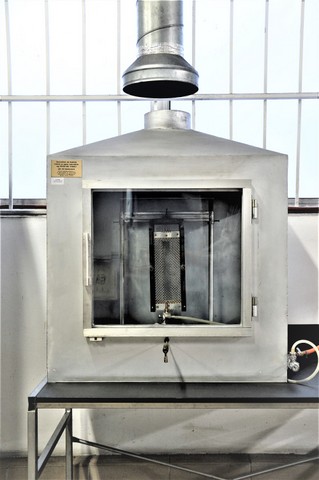PN-EN ISO 11925-2
Laboratory
IGNITABILITY TEST
OF MATERIALS AND PRODUCTS WITH METHODS ACCORDING TO PN-EN
ISO 11925-2 AND PN-EN 45545-2.
Principle of the
method.
The
test are being
conducted in the ventilating chamber. The sample, upright, is being
subjected to the effect of the gas burner flame about the flame
height of 20mm.

Stand
for testing the ignitability of building products and materials.
The
following flame
application times are available:
15s, 30s or 60s. After this time are being moved away burner.
Tests
may need to be conducted to either surface exposure or edge exposure,
or both.
For
each of the test specimens, record the following:
- whether ignition occurs;
- whether the flame tip reaches 150mm above the flame application point, and the time at which this occurs;
- presence of flaming droplets/particles which cause ignition of the filter paper;
- observations of physical behaviour of the test specimen.
Test
specimen.
For each
exposure condition, a minimum of six representative specimens of the
product shall be tested. Three specimens shall be cut lengthwise and
three crosswise. For
products which are normally manufactured in sizes less than the test
specimen, a test sample of appropriate size shall be specifically
produced for the test. If a
product under test is asymmetric through its thickness and in
practice either face may be exposed to a source of ignition, test a
separate series of specimens on each face. Where a
product has areas of its surface which are distinctly different, but
each of these separate areas can satisfy the surface characteristics
for essentially flat products, then more than one test set shall be
conducted to evaluate the product. If a
product is installed with covered edges, but can also be used with
unprotected edges, tests shall be performed on both covered and
uncovered specimens
Dimensions
of the test specimens.
- 250 mm long
- 90 mm wide.
Specimens
normally having a thickness of 60 mm or less shall be tested using
their full thickness. Specimens normally having a thickness greater
than 60mm shall be reduced to a thickness of 60mm by cutting away
the unexposed surface. If it is necessary to reduce the specimen size
in this manner, the cut surface shall not be exposed to the flame.
Applying
research methods:
- civil engineering (requirements according to PN-EN 13501 for European Classification System: B, Bfl, BL, C, Cfl, CL, D, Dfl, DL, E, Efl i EL),
- railways (according to the R4 and R5 requirements of the norm PN-EN 45545-2).


